| Author |
 Topic Topic  |
|
|
|
Richard and Karen
Bronze Member
 
 England England
205 Posts |
 Posted - 16 May 2005 : 2:28:56 PM Posted - 16 May 2005 : 2:28:56 PM





|
Our lovely Mare was diagnosed with Laminitis yesterday, and can hardly move.The Vet has been out, but has anybody got advice on what we can help her with ourselves.
None of our horses have suffered before, and what future effect on her in hand and ridden career could this possibly have.
It is very upsetting to see her looking so sorry for herself.
One problem we are finding is getting bute into her as she is so fussy about anything added to her feed, and refuses to eat a brown mash.
Any advice and support would be welcome.
Richard and Karen
|

 |
|
Report to moderator
|
|
|
nicolanapper
Platinum Member
    
England
4247 Posts |
 Posted - 16 May 2005 : 2:41:30 PM Posted - 16 May 2005 : 2:41:30 PM




|
Bad luck. My Welsh mare has had laminitis too 3 years ago and had a degree of pedal rotation then. At christmas she was ill again but not with laminitis, and had to be treated with cortizone injection (which you cannot usually give to laminitis prone horses) but it was a kill or cure for her as she was going to be put down. This again gave her a degree of pedal rotation, and she is suffering at the moment with being a little foot sore.
My mare is currently on bute and ACP we do not know what the long term prognosis is. She is out with the others now, having jumped the fence from our stable yard to get to the horses after a weeks stable rest.
As this is your mares first episode of the disease hopefully you have caught it on time and know to look for the future for warning signs.
It is a terrible disease though. My mare is a thin as a rake and we cannot keep weight on her, it is no longer a disease of the classic fat pony. I too am experimenting with various herbs and medicines. Talk to you vet though. A lot of the herbs for sale proporting to help laminitics are very expensive, more so than a call out from a vet and the necessary drugs for a month. I suggest you contact the laminitis trust, they may be able to help you.
Good luck, I know you must be feeling very sorry for your horse especially looking so uncomfortable at the moment.
Nicky |
Report to Moderator  |
|
|
Zan
Platinum Member
    
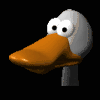
Scotland
3213 Posts |
 Posted - 16 May 2005 : 3:04:35 PM Posted - 16 May 2005 : 3:04:35 PM





|
So sorry to hear about your mare. If you have a good farrier, get him out asap and if you haven't got a good one find one. How her feet are trimmed and supported, possibly with heart bar shoes, is crucial. Heart bars support the foot and help to stop pedal bone rotation and they usually make the horse feel more comfortable almost immediately. I presume you have already cut out all hard feed---from now on (and forever) she should only have fibre feeds such as Happihoof, hay etc.One of mine won't take bute in anything, so I mix it with a little bit of vegetable oil and squirft it into him from a syringe---just like worming.
As to the future, if you deal with it properly now hopefully she should get right back to "normal" and capable of doing anything she does now, except trotting on roads or jumping. Management wiill mean restricting grazing, feeding fibre and not letting her get fat.The Laminitis Trust are brilliant and have a helpline you could phone----0905 105 1051.
Given the time of year it is probably grass related, but Cushings is another common cause---how old is she:any other symptoms.
Best of liuck
Heather |
 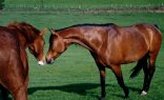 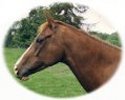  |
Report to Moderator  |
|
|
jaybird
Gold Member
   

France
1192 Posts |
 Posted - 16 May 2005 : 4:19:24 PM Posted - 16 May 2005 : 4:19:24 PM




|
Hi all
Our adorable shetland Pandora suffers from Laminitis, not funny when your grass is over your knees and only one arab to eat it, so a solution had to be found so that she could enjoy her life to the full, I went and purchased a veal mask from the local farm shop and attached this to her headcollar, she now can happily pick about getting the odd strand through the mask, and has small amount of hay at night, fortunately the problem only seems at it's worse in the spring, so for most of winter she grazes normally.If I think she is any pain I fill a small syringe with watered bute and treat like a wormer, so far this is working, the farrier seems to think she has lived with this most of life (getting on a bit now)so maybe there's hope for them with this condition to get to a ripe old age, but all cases are different so fingers crossed.
B (France) |
Report to Moderator  |
|
|
JMRT
Gold Member
   

England
562 Posts |
 Posted - 16 May 2005 : 4:31:18 PM Posted - 16 May 2005 : 4:31:18 PM





|
Hiya
The bute is a must as its an anti inflamatory but also it open up the arteries & allows more blood flow to the feet.
My shetland is wise to bute in feeds too-so we mix it up in an old wormer syringe & squirt it in his mouth. We always give an apple after to get rid of the taste, but at least we know he has had it!
On the laminitus, my old mare had it when she was 14 & he had pedal bone rotation also. Due to the frosty grass one year!!! Once you find out what is your horses trigger you should be able to avoid it. Just careful management & a good farrier will work wonders.
Good luck
Julie |
Julie
|
Report to Moderator  |
|
|
pat day
Moderator
    

United Kingdom
5324 Posts |
 Posted - 16 May 2005 : 4:37:32 PM Posted - 16 May 2005 : 4:37:32 PM






|
Hello Richard and Karen,
Really sorry to read this.
Can you give us an idea on your routine for your mare, it may help to prevent one of our members horses coming down also.
Is she a good doer, was she in work, was she on any hard feed, was she out in day, in at night, or visa versa, or lived out.
How big, what age, is she shod, all these things may help with a comparison.
I really hope she feels more comfortable soon, and that she is a good patient for you.
Thanks in advance, Pat. |
    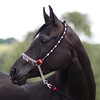   
~~~~~~~~~~~~~~~~~~~~~TREASURES AT TEMPLEWOOD~~~~~~~~~~~~~~~~~~~~~
|
Report to Moderator  |
|
|
Richard and Karen
Bronze Member
 

England
205 Posts |
 Posted - 16 May 2005 : 5:22:21 PM Posted - 16 May 2005 : 5:22:21 PM





|
Thank you for all your advice.
Hi Pat, in response to your post.
She is eight years old and is worked regularly, as we show her a lot in the ridden and in hand.
She is stabled every night and turned out with her brother and mother during the day, and fed barley and sugar beat morning and night.We feed all our horses haylage as hay always seems to make them cough.
She has always been a greedy horse, and this time last year was looking a touch overweight. This year we have been careful with her feed and was showing no excess weight.
Four weeks ago she showed signs of lameness and became very stiff.
She hurt he back last year which was sorted by a physio, but this time she showed no sign of improvement. The vet was once again called out and agreed that she had quite probably hurt her back rolling on a stone and gave her a quarterzone (forgive the spelling) and said we would see a massive improvement in about 5 days.
It took a lot longer than five days, after about 3 weeks we were advised to start lunging her in the school, but she remained very stiff moving through her hind quarters.
What now worries me is that she was becoming slightly lamenetic several weeks ago and had no back problems at all, because she was fine on the soft surface of the school and the field, but as soon as walked onto the hardstanding she again appeared lame.
If this problem indeed began several weeks ago and was not her back as we were told, I will feel totaly devastated that we took the wrong advice and feel incredibly guilty as she is our baby.
Richard and karen |

 |
Report to Moderator  |
|
|
enewton
Gold Member
   

England
549 Posts |
 Posted - 16 May 2005 : 5:32:09 PM Posted - 16 May 2005 : 5:32:09 PM




|
I would have both feet xrayed, to see if there is any pedal bone rotation, then go from there, I have treated a top ridden mare on a stud with cronic laminitis, the pedal bone was about to come through the sole of her foot, bute was not working on her at all, I fed her Sticky weed, dried stinging nettles and willow bark, they strip the bark of the branches weave them through a hay rack, this all gives natural pain killers, and anti-inflamitry properties, the sounder she became, as she begun to recover, the less of this stuff she ate, she went on to carry on her ridden career!! |
Emma Newton
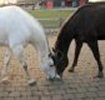 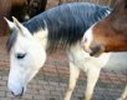 
|
Report to Moderator  |
|
|
Zan
Platinum Member
    

Scotland
3213 Posts |
 Posted - 16 May 2005 : 7:10:49 PM Posted - 16 May 2005 : 7:10:49 PM





|
Hi again
Having read her routine, a couple of points. If it was a "cortisone" injection that your vet gave her,and I can't think waht else it would be, this is steroid and can trigger laminitis. I would never let any of my horses have steroid unless it was a life or death situation for that reason---some can get away with it and some can't and there's no way of knowing till it's too late.I would cut out the barley from now on and make sure the sugar beet is unmolassed. My boy had laminitis before I got him and is sound as a pound and working as a "normal" horse, but I was advised by the Laminitis Trust not to give him haylage. Partly because it is usually richer than hay, but mostly because of the higher bacterial content. There is a link with laminitis and bacteria in the hind gut. Don't think haylage could give laminitis to a horse with no history of it, but probably safer to avoid it now that she is prone to it, and definitely during recovery.One other point: fertilised grass can be really dangerous to horses, even if you limit grazing and they don't get fat , especially if it is high in nitrogen. Czar is out 4-5 hours per day on unfertilised grass, again on the recommendation of Laminitis Trust.
Try to keep positive---I also have a rescued pony whose pedal bones had ruptured through her soles on both her front feet and she is doing fine.There is life after laminitis |
    |
Report to Moderator  |
|
|
Kazzy
Platinum Member
    

England
3335 Posts |
 Posted - 16 May 2005 : 8:36:00 PM Posted - 16 May 2005 : 8:36:00 PM




|
Hi Karen,
So sorry to hear about your mare, I have a chronic lamenitic,
and it is awful to see them in so much pain, you want to have
the pain for them dont you, so they arent suffering.
What everyone has said before is spot on, mine suffers it
mostly in winter time due to trauma or concussion, so she
doesnt go out when it is frosty, she is fed high fibre cubes,
happy hoof and carrots, because she is on a high fibre fibre diet
she gets a vitimin & mineral supplement which is essential, i
use selenivite E but there are others on the market just as good,
I also use Indian Herbs (which I swear by) I get mine from
global herbs and she is on the Laminitis Prone supplement permantely, when she got it bad last year she was on that plus
one called Immuplus for the immune system, it has anti oxidents
in it, which breaks down the bad Free Radicals that enter the
bloodstream which causes the laminitis.
My mare was given zero chance of surviving 17 months ago, but with
careful managment and as said before A MUST excellent farrier she
is o.k leading a relative normal life she not grazing 24/7 but
she is fine, only one thing she cant trot on hard ground like concrete or tarmac she gets sore, but my you want to see her go in the field like a bullet.
Buy the way my mare wont have equipalazone bute either, I used to
have to syringe it down her, but my vets have started using the
new product on the market aswell called DANILON EQUIDOS its yellow
granules and has no taste or smell it does everything bute does,
anti inflammarty (spelling) pain killer etc and the best thing
both of mine EAT IT! Its a couple of pence dearer than bute and is a lot safer my vet says "its better on your horses intestinal tract,
has less risk of causing gastric ulcers and they can be on it long
term without all the side effects that bute could cause".
Just to let you know my mare first got Laminitis when she was 9
she is now 17 although she is not ridden (but thats down to me
not wanting to ride her) she could have been ridden early on when
she recovered the first few times. Careful management for the rest
of her life and hope she doesnt get it again you should hopefully
be back riding her.
Good luck
Janet |
     
Sunny Cheshire |
Report to Moderator  |
|
|
Kazzy
Platinum Member
    

England
3335 Posts |
 Posted - 16 May 2005 : 8:42:16 PM Posted - 16 May 2005 : 8:42:16 PM




|
Hi karen
Me again, forgot to say I wouldnt feed Haylage again its a NO NO
for laminitics, If my hay is dusty I soak it in a bin for half hour
then let it drain and feed it her both of mine get soaked hay
better for them than dried hay and they both prefer it soaked.
Dont leave it soaking all day though all the nutrients get soaked
away and the hay will start to smell, especially this time of year.
janet |
     
Sunny Cheshire |
Report to Moderator  |
|
|
Richard and Karen
Bronze Member
 

England
205 Posts |
 Posted - 16 May 2005 : 9:01:35 PM Posted - 16 May 2005 : 9:01:35 PM





|
Thankyou everyone for your advice and comments.
We are still waiting for our vet (will be seeking new one in the morning)
We spoke to our Farrier at 6pm this evening who came over straight away, has fitted support shoes and filled with resin.
We could see the relief in Rusila our mares face as soon as he finished which was wonderful to see.
He also is quite certain that we have caught it in time and can see no bruising.
With this experience we wish we had made the phone call to him first rather than our new vet (past vet)
Again thankyou all for your comments, we now feel a lot happier now that someone namely our Farrier who has taken control of the situation and has given us peace of mind.
Thanks everyone
Richard and Karen |

 |
Report to Moderator  |
|
|
DawnBrookes
Gold Member
   

United Kingdom
647 Posts |
 Posted - 16 May 2005 : 10:20:03 PM Posted - 16 May 2005 : 10:20:03 PM




|
pleased your mare is now more comfortable, nothing to add to the above comments but just to confirm there IS life after laminitis! my mare had it a few years ago - vet and farrier both astounded and to this day the only explanation is that it was the year we had very hot days and very cold nights in april. It also seems to have coincided with when she stopped growing? She was only very slightly stiff in one foreleg, but when her feet grew all four had been affected. Thankfully no permanent damage and I was riding her again in about 6 weeks. She is now an advanced endurance horse! Fed on a high fibre/high oil diet and watched like a hawk! I start restricting grazing from early March, although she is still out 24hrs, keep her on small paddock during the day with hay if she wants it.
She is now shod in front with the same shoes as the back (ie. side clips rather than one in the centre, can't remember what you call it!) initially this was due to the damaged hoof growth, but we have stayed with it as she seems much better and doesn't wear her toes out like she used to.
Good luck, sounds like you have caught it early enough so don't worry!!
xx |
Report to Moderator  |
|
|
pathannay
Gold Member
   
United Kingdom
938 Posts |
 Posted - 16 May 2005 : 11:22:33 PM Posted - 16 May 2005 : 11:22:33 PM




|
Karen and Richard
So glad you seem to have solved your problem with your mare - I am thinking this was the mare Dave was moving for you today? Hope she gets better soon.
On another note - my lorry was transported by RAC Commercial Assist back to my house this evening - I made the transporter man drive it down my drive as its quite steep and I didnt feel ready to face that yet!! Now I have to wait for the assessors to decide whether it is repairable or a right off!
See you at Wales & West on Friday night - I will probably need a large G & T after driving over!!
Pat
|
www.azizaarabians.co.uk |
Report to Moderator  |
|
|
Sabaska
New Member
England
6 Posts |
 Posted - 17 May 2005 : 07:10:29 AM Posted - 17 May 2005 : 07:10:29 AM




|
Dear Richard and Karen
I having worked as a nutritionist for a horse feed company for many years and I have a few articles that may help with your lamanitic mare. My email address is lindakennard@blueyonder.co.uk If you would like to read more about the condition please feel free to contact me.
Regards
Linda |
Report to Moderator  |
|
|
Kazzy
Platinum Member
    

England
3335 Posts |
 Posted - 17 May 2005 : 08:32:37 AM Posted - 17 May 2005 : 08:32:37 AM




|
Dear Karen,
Looks like you have caught it in time, Indeed your farrier knows
best when it comes to laminitis, mine is a godsend and is really
knowledable regarding laminitis, like i said previously she was on
deaths door till darren stepped in took control totalling reformed
her feet and she is ok apart from her strained tendon! (another story).
just a little note I have started using magnetic tendon boots on her
at night when she is in the stable because she can be a bit stiff
in the morning and it has helped her no end. They encourage
blood flow and repair some damage, some people dont beleive in them
to be honest I thought they wouldnt work, but I can see a big
difference in the morning she is no where near as stiff.
Keep smiling its not the end theres plenty of advice and help
these days for these laminitics!
Janet |
     
Sunny Cheshire |
Report to Moderator  |
|
|
Sasha Melia
Gold Member
   

England
1333 Posts |
 Posted - 17 May 2005 : 12:17:05 PM Posted - 17 May 2005 : 12:17:05 PM





|
I have a mare that is prone to being very fat on fresh air who apparently had mild lamintis whilst she was out on breeding loan (although they never told me this until I asked them why they had sent her back to me looking like an RSPCA case). She was loaned out for nearly 2 years whilst she had a foal for them, and I eventually got her back home in Feb 2004 in a terrible state.
She is now 13 and I have owned her for 9 years and she has never had laminitis as such whilst she has been with me although last summer after coming back from loan the vet said that her digital pulse was raised and to keep her off the grass. Anyway she is now very well and again very fat I'm afraid, she lives on a sectioned off area of about half an acre of practically just earth with the odd bit of weed! However she is pregnant and due to foal in 3 weeks and I am wondering if anyone has experience of pregnant mares with laminitis. My mare gets one feed a day now that she is close to her due date, a scoop of alflafa lite and a scoop of D&H Mare & Youngstock mix plus some Benevit vit & mineral supplement, also she gets a couple of sections of hay to give her something to munch on as there's nothing in the field at all. I worry that I am not giving her anywhere near the amount of stud mix she should be getting at this stage of pregnancy but she with the threat of laminitis and with her looking so well it's very hard to know! |
www.facebook.com/MukhtarIbnEternity
www.mukhtaribneternity.co.uk
   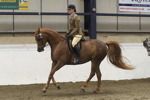  
****************************SILHOUETTE ARABIANS****************************
Home of Mukhtar Ibn Eternity (Eternity Ibn Navarrone-D x Monsoon by Djammal) AKA Mooky! |
Report to Moderator  |
|
|
Wyllow
Platinum Member
    

United Kingdom
2885 Posts |
 Posted - 17 May 2005 : 3:11:39 PM Posted - 17 May 2005 : 3:11:39 PM





|
Hi Richard and Karen
My sympathies.
I have a Welsh B mare , 13 years old, who had a bout of laminitis prior to us owning her.
A good Farrier is a big plus and Milly's probably saved her by doing what your's did and putting a resinous type substence beneath rubber soles to support her feet and make her comfortable. She was still wearing them when I bought her ~ wouldn't reccommend this situation but I wanted herfor reasons other than having a 100 per cent sound working pony.
So many things can trigger this condition:
Too much weight
Too rich a diet ~ cut out ALL sort of sugar rich food including beet and mix and any grain at all and NO TREATS ~ even CARROTS are sweet ~ think about it, really! Feed high fibre foods like happy hoof reccommended by the laminitis trust. They have lists of advised foodstuffs to suit all and all sorts of info.
A feed balancer to get the most from the rations allowed is reccommended and to supplement vitamins and minerals not aquired by other means.
Biotin plus was also mentioned to me to condition feet and certainly seems to have helped mine.
Also get yourself a good DETOXER ~ there are several around made by companies like NAF. They help soak up unwanted "baddies" in the system.Mine is provider by a local man who specialises in natural remedies ~ they certainly helped Milly.
Grazing muzzles are good to cut down grass intake but it's probably less of a risk to restrict paddocks and if necessary put the horse in a bare paddock for part of the time with hay and water. It looks dreadful, I know, but it's better than being in or getting fat.Company can be an issue ~ I'd mention that. Mine is grazed in the next little field to the others and so can see companions at least on either side.Mirrors proved VERY useful to combat that feeling of isolation when Milly was at home losing weight on her own.
Don't over fertilize pasture!!!!!!!!!! It makes the grass rich!!!!!!! Do you recall a time when lamintitis was not so common? Do you also recall a time when pasture was "rougher" and hardly so "manicured"? I've had this advice given by several people and it seems to be very sensible.
Don't ever turn out on grass that has been frosted. Wait for it to thaw and give it a while on top as when grass thaws out the fructose rushes to the tip and makes it leathal ~ a farmer who specialises in hay growth and providing pasture for horses locally told me that.
Haylage is a complete no-no because of the higher calorific value and the different bacteria.
Trotting or cantering on hard surfaces can concuss a damaged foot more and is out too, I'm afraid in some or most cases.
Milly lives out 24/7 at this time of the year.
She is on very restricted pasture and has supplementary hay.
She doesn't like being on a diet but as long as she stays relatively slim, she's fine.
She does no fast work or jumping if the ground is hard and never trots on tarmac very far.
I'll mention this too, though ~ we had a scare last winter because of imported CANADIAN HAY!!!!
It was FAR richer than English or local and set her off for a day or two ~ not badly but enough to bruise more than a little and make her footy for a week ~ but VERY scary.
She immediately came off it and back on good old woody local stuff and was fine.
Milly has a handful of lite pasture mix with balancer and biotin plus every day for tea and a simple small ammount of mix and chaff for breakfast, hay in moderation and a little restricted grass, but has enough area to exercise.
This has kept her healthy and fit for three years bar that incident with the HAY in the middle of WINTER if you please!
You will learn what is an ideal weight and what keeps condition on without too much fat.
You'll also find that grass watching becomes second nature and that your checking of feet does so too!
It seems a happy fact that you've been vigilant enough to catch this early and I hope all will be well for your horse.
This is a terrifying disease and you have managed to catch it fast.
Because you are clearly vigilant I'm sure you'll be able to prevent it again and minimise the risks.
You have a good farrier too and that's great ~ all in all, I'd say it all looks very hopeful foryour horse ~ there CAN BE a GOOD life after laminitis and you seem very capable of ensuring it for your horse. Good luck! |
Report to Moderator  |
|
|
pat day
Moderator
    

United Kingdom
5324 Posts |
 Posted - 17 May 2005 : 5:10:06 PM Posted - 17 May 2005 : 5:10:06 PM






|
Richard and karen.
Thanks for all the extra information.
I will say your routine is probably about the same as mine except, perhaps yours get only a bit more bucket feed, and I try to limit grazing to max 6 hours when the grass is growing as it is.
This is because Taklimakan is such a good doer.
Its very scary. I will defo keep a very close eye on mine.
Keep us informed of her progress wont you.
Take care, Pat. |
       
~~~~~~~~~~~~~~~~~~~~~TREASURES AT TEMPLEWOOD~~~~~~~~~~~~~~~~~~~~~
|
Report to Moderator  |
|
|
Richard and Karen
Bronze Member
 

England
205 Posts |
 Posted - 18 May 2005 : 12:01:57 PM Posted - 18 May 2005 : 12:01:57 PM





|
Hi All Rusila has shown a great improvement since our Farrier treated her, she is now moving around the stable, and is calling to the other horses.She is a lot more comfortable in herself and has even got stroppy with her brother and bit him last night, a bit ungrateful as he has been keeping he company in the next stable.
We are feeling a lot happier now we can see signs of improvement.
Thanks for the support and advice from everyone.
Note for Pat We will be wll stocked with gin friday night, see you then.
Richard and Karen |

 |
Report to Moderator  |
|
|
Basilisk
Gold Member
   
United Kingdom
521 Posts |
 Posted - 18 May 2005 : 1:14:31 PM Posted - 18 May 2005 : 1:14:31 PM




|
Another good tip for laminitis management is when restricinig grazing, turn out at NIGHT, and keep the horse in in the DAY. Sugar levels in grass are highest in the daytime (photosynthesis) and lowest at night, so night-time grazing is less likely to trigger an attack.
Keren |
Report to Moderator  |
|
|
angel2002
Platinum Member
    
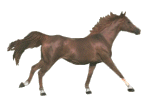
United Kingdom
2502 Posts |
 Posted - 18 May 2005 : 1:51:41 PM Posted - 18 May 2005 : 1:51:41 PM




|
Keren beat me to it :)) I would turn a lamanitic out at night for the same reasons.....
Angel |
Angel
Passion Arabians
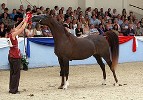  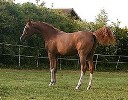  |
Report to Moderator  |
|
|
tamila
Platinum Member
    
England
2532 Posts |
 Posted - 18 May 2005 : 1:54:48 PM Posted - 18 May 2005 : 1:54:48 PM




|
You could try feeding a probiotic such as Prevent and Lakota salts in her feed everyday. I can give you a phone number of someone, who si a nutritionist specialising in difficult horses and is particularly good with laminitics. 
My e.mail address is Pauline.mackenzie1@ntlworld.com |
   |
Report to Moderator  |
|
| |
 Topic Topic  |
|

